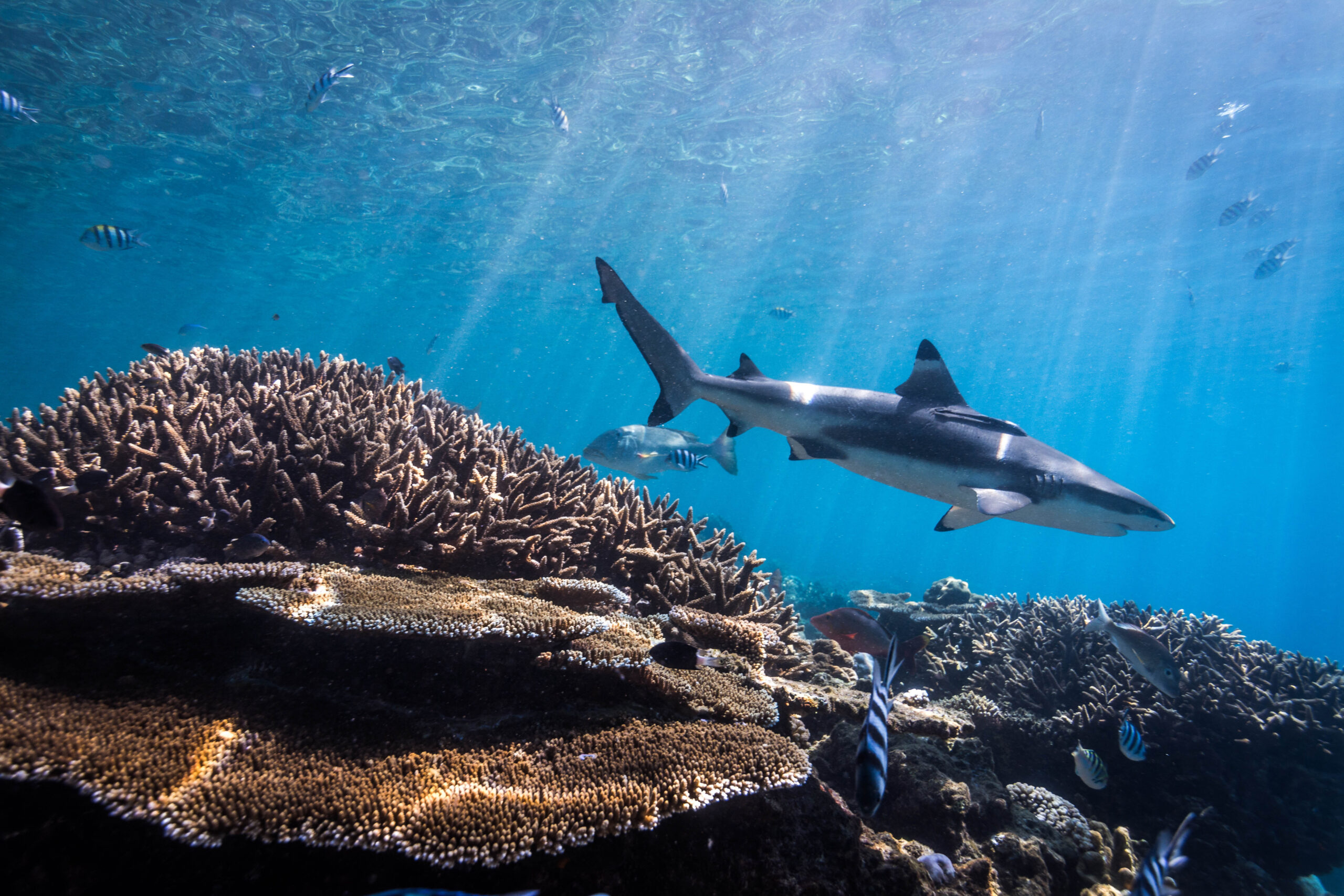Using traditional knowledge to guide coastal fisheries management planning in the Koror Southern Lagoon, Palau
Location
Koror Southern Lagoon, Palau
The challenge
In the global reef community, Palau is known for its achievements in marine conservation, most notably, the designation of protected areas large and small, and the protection of coral reefs. One of Palau’s strengths has been the ownership of natural resources which remain with the Palauan people and communities who own, use, and have a direct stake in the conservation of resources. This strong connection—and the importance of marine resources to cultural practices—means there is a desire and commitment from communities and state governments to manage resources well. Unfortunately, over the past two decades, there has been a gap in community involvement and the integration of traditional knowledge in resource management which has resulted in management measures at the government level focused on limiting species extraction rather than a community and ecosystem-based approach. This has led to overharvesting and gaps in regulations and has contributed to the decline of Palau’s coastal fisheries in certain areas.
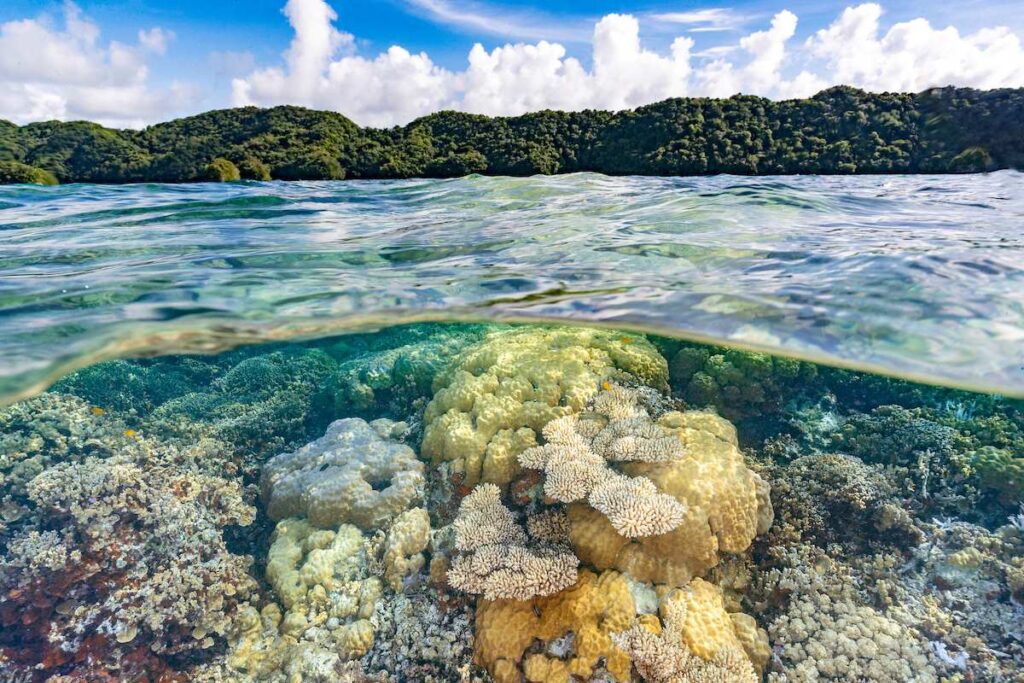
Split view of a coral reef in Palau. Photo © Kip Evans, CCC Marketing LLC
Palau’s Northern Reefs Fisheries Management Plan was launched in Palau’s northern reefs with the states of Kayangel and Ngarchelong in 2016. The plan was designed in collaboration with communities and fishers integrating their intimate understanding of species’ habitats, behaviors, and life cycles. Several management measures are now implemented, and regulations are in place in both states thanks to the Coastal Fisheries Management Acts. Using this effort as a successful model to replicate the engagement of fishers and incorporation of their knowledge into management plans, the Koror State Government (KSG) launched a process to safeguard Koror State’s fisheries.
Actions taken
Developing a plan
In 2020, Koror State Government, with the House of Traditional Leaders, started a planning process to develop a multi-species fisheries management plan for the Koror southern lagoon using traditional knowledge and contemporary scientific knowledge. This process was guided by a fisheries planning team led by a traditional chief, made up of local fishers and partners, with assistance from the Palau Conservation Society (PCS). The result of these efforts was the Koror Coastal Fisheries Management Plan, a plan to recover valued reef fish and invertebrates from overharvesting, rebuild populations for sustainable harvesting alongside healthy ecosystems, and ensure the Koror community is sustainably benefitting from its coastal fisheries.
Key steps to develop the collaborative Fisheries Management Plan (FMP) included:
- Establishing a Koror Fisheries Planning Team. The Team consisted of local fisheries experts who represented the fishing community of Koror, KSG’s Department of Conservation and Law Enforcement (DCLE), PCS, the Office of PALARIS, Palau International Coral Reef Center (PICRC), and The Nature Conservancy (TNC).
- Interviewing Koror fishers. The Team developed an open-ended questionnaire, met with hamlet legislators for guidance on who to interview, and conducted group interviews in villages to learn about local fish species (e.g., behavior, habitat, life cycles, importance to community, etc.) and fishing practices. Additional meetings targeted female fishers to fill a noticeable gap in female participation.
- Analyzing the data. After the fisheries interviews, data gathered were compiled and analyzed and then used to guide the subsequent field work.
- Collaborative mapping of fishing grounds. The team and GIS surveyors from PALARIS conducted field work together to map the five categories of fishing grounds identified by the fishers through the interview process.
- Verifying the mapping results. Fishers led more than 30 meetings, which included site visits, state leadership meetings, and technical meetings with PICRC, TNC, KSG DCLE, and the Bureau of Fisheries to discuss data and draft maps. This process resulted in fisheries sustainability measures, which included spatial, non-spatial, and temporal measures, and a detailed map of traditional fishing grounds in Koror, which included the use of traditional names.
- Identifying key species to manage. The Team gathered available data on Koror fish species and then coordinated meetings with local fishers and other fisheries experts and scientists, including invertebrate experts from the Bureau of Fisheries. Fishers led this process, identifying which fish species are in Koror and which are most important to the people of Koror. With input from TNC fisheries scientists, they also identified which species needed urgent attention with regards to their population.
- Developing a collaborative FMP. PCS staff compiled the interview data, maps, and lists of key species to draft the FMP. Scientific and technical support for this plan was provided by the Bureau of Fisheries, PICRC, TNC, and PALARIS. The draft FMP was then shared with the Team and the fishers who participated in the process, and feedback was incorporated into a final FMP.
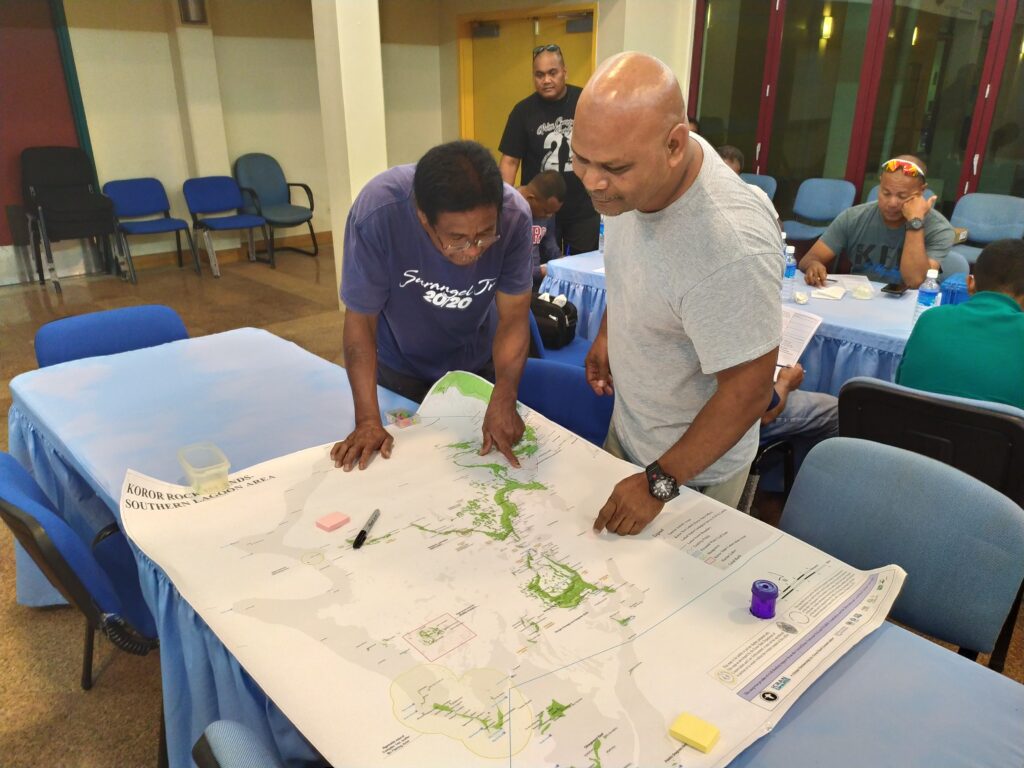
Koror hamlet fishers consultations. Photo © Palau Conservation Society
Implementing the FMP
To support the implementation of the FMP, KSG engaged PCS to develop an implementation plan and help execute activities to build their capacity. This work was supported by the Resilient Reefs Initiative (RRI)—a global partnership enabling holistic resilience-based management in four World Heritage-listed pilot reef sites. Capacity-building activities included training KSG staff, year-one work planning, and conducting a gaps and needs assessment to identify areas within KSG that need improved capacity. KSG is currently working with RRI, PCS, TNC, and PICRC to develop projects that will track the health of the fishery, train KSG staff and rangers, and build their institutional capacity to implement the FMP.
How successful has it been?
In 2021, Koror State Government formally adopted the Koror Coastal Fisheries Management Plan. Plan supporters are currently working to have the Legislature pass the Koror Coastal Fisheries Management 2021 legislative bill—which would establish fishing regulations for Koror State for the first time.
The FMP was the first for Koror State and has the potential for impactful on-ground outcomes, due to the fact that it is a multi-species plan, expertly drawing on traditional and contemporary knowledge, and the first time that fish catch has been regulated in Palau’s most populous state where fish are the cornerstone of culture and tradition.
While implementation is only the beginning, it’s clear that the process of developing the FMP has helped strengthen the ecological, social, and governance resilience of the local area. This is typical of a resilience approach, in that both the action itself as well as the process of planning and implementing the action serve to build resilience.
Ecologically, clear objectives and actions for the conservation of threatened fish stocks have been defined and monitoring programs to track progress have been established. Management actions look beyond species management to include management of key fisheries habitats, species migration routes and aggregation sites, and the ecosystems within them.
Socially, the meaningful and empowering way that stakeholder engagement was conducted has helped to build the foundation for trust, equity, and shared purpose between all parties. Fishers, including women, were authentically engaged and their expertise drove the decisions that created the plan. They were also involved from the beginning of the project to the end, when the Team presented the draft FMP to Koror leadership. Relationships between fishers and scientists were established and/or strengthened, and the stigma of the local NGO, PCS, as an organization that “just closes fishing grounds” was ended.
From a governance perspective, the process of collaborative co-design has laid the foundation for buy-in and support for implementation. This plan was developed as much by the community as it was by the management agency. It responds to local concerns and recognizes local barriers and opportunities. Furthermore, the gaps and needs assessment helped identify areas within KSG that need improved capacity and paved the way for partners to support FMP implementation.
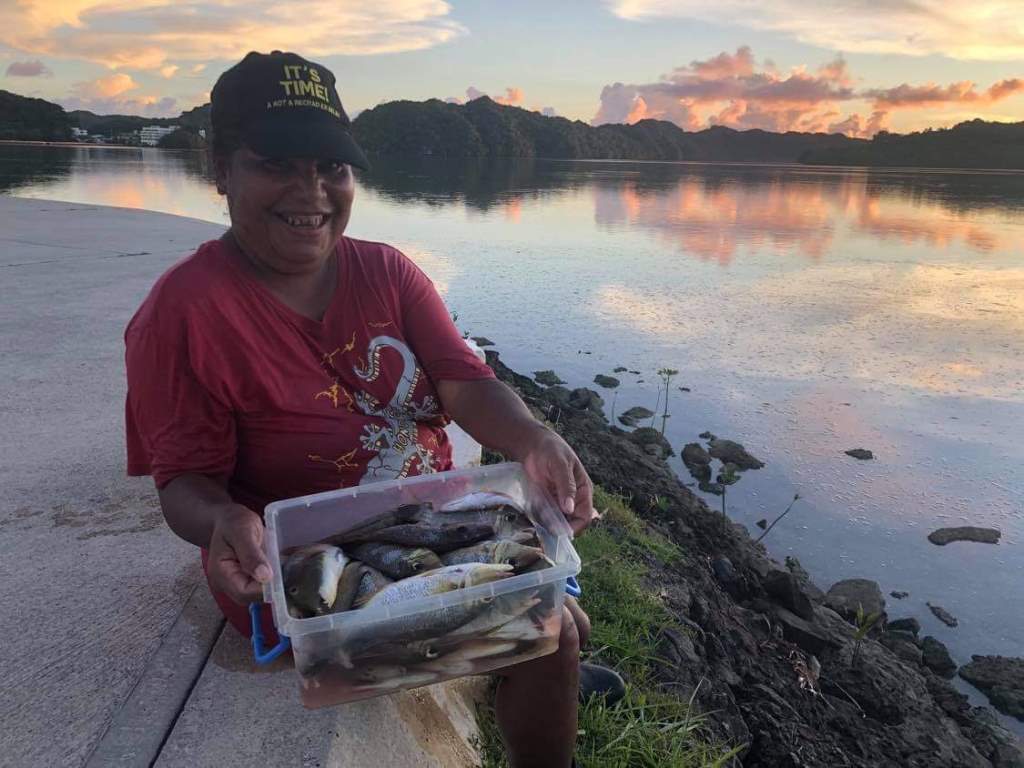
Meyuns fisher. Photo © Palalu Conservation Society
Lessons learned and recommendations
- Develop a planning team that is representative of the group(s) you want to engage. The most valuable asset of the Team was the knowledge of the participating fishers and the fact that they are well acquainted and known within the fishing communities. This made the Team strategic in who it engaged and how, and more approachable and credible within the fishing community.
- Engage underrepresented groups. Assessing gaps in representation within stakeholder engagement can help to ensure that a broad range of perspectives and types of knowledge are incorporated. Initially, women did not participate in the interviews, due to the social stigma that women do not participate in fishing. To address this challenge, the Team invited specific female fishers from each hamlet to participate in female-only group meetings. In this setting, the female fishers shared their knowledge and experience freely and provided invaluable insights into fisheries management.
- Stakeholder empowerment builds buy-in for implementation. The Team focused on providing stakeholders opportunities to engage and provide input, as well as opportunities for stakeholders to lead aspects of the engagement. Empowering stakeholders to be involved in the planning process empowers them to be involved in and advocate for the implementation of the FMP.
- Diversity of knowledge leads to more robust outputs. A key strength of the process was the integration of lived experience, scientific data, and traditional/cultural knowledge within the planning process. The engagement was structured in ways which clearly demonstrated to participating stakeholders that each type of knowledge was valued. Combining all of these types of knowledge produced insights and outcomes that made the eventual FMP more robust and effective.
- The process of developing a plan can bring stakeholders closer together. Engagement between different stakeholders (e.g., between scientists, managers, and fishers when conducting collaborative mapping) helped deepen knowledge about the system, as well as about the values, beliefs, and challenges of other stakeholders. This common understanding is a fundamental first step towards collaborative management.
- Be patient. Collaborative processes take time as does building support and creating new legislation.
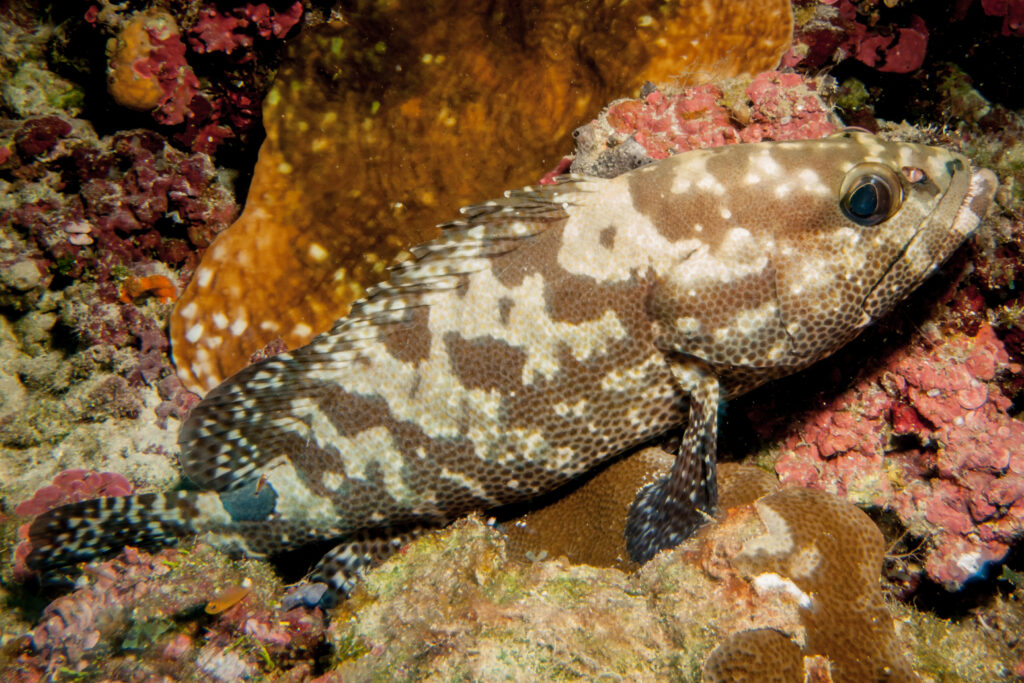
Marbled Grouper in Palau. Photo © Madara Hata, PICRC
Funding summary
FMP development was funded by the Micronesia Conservation Trust. Key projects from the FMP implementation plan were funded through the Resilient Reefs Initiative, which is being delivered in Palau by Koror State Government Department of Conservation and Law Enforcement in collaboration with the Great Barrier Reef Foundation, The Nature Conservancy’s Reef Resilience Network, Columbia University’s Center for Resilient Cities and Landscapes, Resilient Cities Catalyst, UNESCO, and AECOM. The initiative is enabled by the BHP Foundation.
Lead organizations
Koror House of Traditional Leaders
Palau International Coral Reef Center


